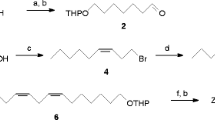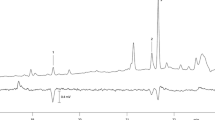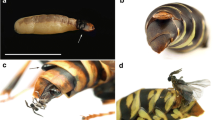Abstract
Lycoriella ingenua Dufour (Diptera: Sciaridae) is acknowledged as the major pest species of the white button mushroom, Agaricus bisporus, throughout the world. Components of the female-produced sex pheromone of this species were identified previously as C15-C18 n-alkanes, with the major component n-heptadecane, and shown to be attractive to L. mali. However, a subsequent report could not repeat this work. We reinvestigated the sex pheromone of this species by confirming that virgin females were attractive to males in a Y-tube bioassay and by collection of extracts from virgin females. Extracts were analyzed by gas chromatography coupled to electroantennographic detection, and by the less widely-used technique of gas chromatography coupled to a behavioral bioassay to detect compounds causing wing-fanning and copulatory abdomen curling in males. A single, behaviorally-active pheromone component was isolated and characterized by gas chromatography coupled to mass spectrometry. This component was definitively not n-heptadecane or any of the other C15-C19 n-alkanes reported previously, but is proposed to be a sesquiterpene alcohol having analytical characteristics that closely matched those of reference germacradienols.






Similar content being viewed by others
References
Alberts SA, Kennedy MK, Cardé RT (1981) Pheromone mediated anemotactic flight and mating behavior of the sciarid fly Bradysia impatiens. Environ Entomol 10:10–15
Bartlett GR, Keil CB (1997) Identification and characterization of a permethrin resistance mechanism in populations of the fungus gnat Lycoriella mali (fitch) (Diptera: Sciaridae). Pest Biochem Physiol 58:173–181
Borges M, Birkett M, Aldrich JR, Oliver JE, Chiba M, Murata Y, Laumann RA, Barrigossi JA, Pickett JA, Moraes MCB (2006) Sex attractant pheromone from the rice stink bug, Tibraca limbativentris stal. J Chem Ecol 32:2749–2761
Brazil RP, Hamilton JG (2002) Isolation and identification of 9-methylgermacrene-B as the putative sex pheromone of Lutzomyia cruzi (Mangabeira, 1938) (Diptera: Psychodidae). Mem Inst Oswaldo Cruz 97:435–436
Brazil RP, Caballero NN, Hamilton JG (2009) Identification of the sex pheromone of Lutzomyia longipalpis (Lutz & Neiva, 1912) (Diptera: Psychodidae) from Asunción, Paraguay. Parasit Vectors 2:51. doi:10.1186/1756-3305-2-51
Brewer KK, Keil CB (1989) A mixed function oxidase factor contributing to permethrin and dichlorvos resistance in Lycoriella mali (fitch) (Diptera: Sciaridae). Pestic Sci 26:29–39
Cantelo WW (1979) Lycoriella-mali (Diptera: Sciaridae) - control in mushroom compost by incorporation of insecticides into compost. J Econ Entomol 72:703–705
Cantelo WW (1983) Control of a mushroom-infesting fly (Diptera: Sciaridae) with insecticides applied to the casing layer. J Econ Entomol 76:1433–1436
Cardé RT, Minks AK (1995) Control of moth pests by mating disruption: successes and constraints. Annu Rev Entomol 40:559–585
Cornwell P, Reddy N, Leach DN, Wyllie SG (2001) Germacradienols in the essential oils of the Myrtaceae. Flavour Fragr J 16:263–273
Erler F, Polat E, Demir H, Catal M, Tuna G (2011) Control of mushroom Sciarid fly Lycoriella ingenua populations with insect growth regulators applied by soil drench. J Econ Entomol 104:839–844
Frank J, Dettner K (2008) Sex pheromones in three Bradysia species (Dipt., Sciaridae): novel bioassays with female body extracts and fractions. J Appl Entomol 132:513–518
Gotoh T, Nakamuta K, Tokoro M, Nakashima T (1990) Copulatory behavior and sex pheromones in sciarid fly, Lycoriella mali (Fitch) (Sciaridae: Diptera). Jpn J Appl Entomol Zool 43:181–184
Hall DR, Amarawardana L, Cross JV, Francke W, Boddum T, Hilbur Y (2012) The chemical ecology of cecidomyiid midges (Diptera: Cecidomyiidae). J Chem Ecol 38:2–22
Hamilton JG, Ward RD, Dougherty MJ, Maignon R, Ponce C, Ponce E, Noyes H, Zeledon R (1996) Comparison of the sex- pheromone components of Lutzomyia longipalpis (Diptera: Psychodidae) from areas of visceral and atypical cutaneous leishmaniasis in Honduras and Costa Rica. Ann Trop Med Parasit 90:533–541
He X, Cane D (2004) Mechanism and stereochemistry of the germacradienol/germacrene D synthase of Streptomyces coelicolor A3(2). J Am Chem Soc 126:2678–2679
Hummel HE (1984) The tandem gas chromatography – behavior bioassay. In: Hummel HE, Miller TA (eds) Techniques in pheromone research, 1st edn. Springer, New York
Kostelc JG, Girard JE, Hendry LB (1980) Isolation and identification of a sex attractant of mushroom-infesting sciarid fly. J Chem Ecol 6:1–11
Kovats E (1965) Gas chromatographic comparison of organic substances in the retention index system. Adv Chromatogr 1:229–247
Leal WS, Hasegawa M, Sawada M (1992) Identification of Anomala schonfeldti sex pheromone by high-resolution GC-behavior bioassay. Naturwissenschaften 79:518–519
Leal WS, Hasegawa M, Sawada M (1994) Sex pheromone of oriental beetle, Exomala orientalis: identification and field evaluation. J Chem Ecol 20:1705–1718
Leal WS (2005) Pheromone reception. Top Curr Chem 240:1–36
Lewandowski M, Sznyk A, Bednarek A (2004) Biology and morphometry of Lycoriella ingenua (Diptera: Sciaridae). Biol Lett 41:41–50
Li HJ, He XK, Zeng AJ, Liu YJ, Jiang SR (2007) Bradysia odoriphaga copulatory behavior and evidence of a female sex pheromone. J Agric Urban Entomol 24:27–34
Li HJ, He XK, Zeng AJ, Liu YJ, Jiang SR (2008) Evidence of a female sex pheromone in Bradysia odoriphaga (Diptera: Sciaridae). Can Ent 140:324–326
Oliveira MWM, de Borges M, Andrade CKZ, Laumann RA, Barrigossi JAF, Blassioli-Moraes MC (2013) Zingiberenol, (1S, 4R, 1′S)-4-(1′,5′-dimethylhex-4′-enyl)-1-methylcyclohex-2-en-1-ol, identified as the sex pheromone produced by males of the rice stink bug Oebalus poecilus (Heteroptera: Pentatomidae). J Agr Food Chem 61:7777–7785
Park I-K, Choi K-S, Kim D-H, Choi I-H, Kim L-S, Bak W-C, Choi J-W, Shin S-C (2006) Fumigant activity of plant essential oils and components from horseradish (Armoracia rusticana), anise (Pimpinella anisum) and garlic (Allium sativum) oils agaist Lycoriella ingenua (Diptera: Sciaridae). Pest Manag Sci 62:723–728
Park KC, Baker TC (2002) Improvement of signal-to-noise ratio in electroantennogram responses using multiple insect antennae. J Insect Physiol 48:1139–1145
Park KC, Ochieng SA, Zhu J, Baker TC (2002) Odor discrimination using insect electroantennogram responses from an insect antenna1 array. Chem Senses 27:343–352
Robards K, Haddad PR, Jackson PE (1994) Principles and practice of modern chromatographic methods. Academic Press, New York
Shamshad A (2010) The development of integrated pest management for the control of mushroom sciarid flies, Lycoriella ingenua (Dufour) and Bradysia ocellaris (Comstock), in cultivated mushrooms. Pest Manag Sci 66:1063–1074
Shamshad A, Clift AD, Mansfield S (2008) Toxicity of six commercially formulated insecticides and biopesticides to third instar larvae of mushroom sciarid, Lycoriella ingenua dufour (Diptera : Sciaridae), in New South Wales, Australia. Aust J Entomol 47:256–260
Wicker-Thomas C (2007) Pheromonal communication involved in courtship behavior in Diptera. J Insect Physiol 53:1089–1100
Witzgall P, Stelinski L, Gut L, Thomson D (2008) Codling moth management and chemical ecology. Annu Rev Entomol 53:503–522
Yu F, Harada H, Yamasaki K, Okamoto S, Hirase S, Tanaka Y, Misawa N, Utsumi R (2008) Isolation and functional characterization of a β-eudesmol synthase, a new sesquiterpene synthase from Zingiber zerumbet smith. FEBS Lett 582:565–572
Zar J (2009) Biostatisical analysis, 5th edn. Prentice Hall, Upper Saddle River, NJ
Acknowledgments
We thank Nate McCartney of the Jim Tumlinson laboratory at Penn State for his help in obtaining mass spectra on the HP-5MS and DB-225 columns. We are grateful for the helpful discussions concerning mass spectra of germacradienols that we had with Dr. Cam Oehlschlager of ChemTica Internacional, Prof. Jocelyn Millar at the University of California, Riverside, Prof. David Cane and Dr. Wayne Zhou of Brown University, and Prof. Dr. Stefan Schulz of the Technical University Braunschweig. Collaboration continues with the latter two laboratories and with Prof. David Hall, University of Greenwich, to determine the structure of this germacradienol. This project was supported by USDA/AFRI/SCRI grant No. 2012-51181-19912 entitled, “Addressing Management Gaps with Sustainable Disease and Pest Tactics for Mushroom Production”, Prof. David M. Beyer, Penn State University, Principal Investigator. Support for Dr. Haibin Chen’s participation comes from the Special Fund for Agro-Scientific Research in the Public Interest in China, Grant No. 201203036.
Author information
Authors and Affiliations
Corresponding author
Ethics declarations
Conflict of Interest
The authors have no conflicts of interest, financial or otherwise, that bias our work in any way.
Additional information
Stefanos S. Andreadis and Kevin R. Cloonan contributed equally to this work.
Rights and permissions
About this article
Cite this article
Andreadis, S.S., Cloonan, K.R., Myrick, A.J. et al. Isolation of a Female-Emitted Sex Pheromone Component of the Fungus Gnat, Lycoriella ingenua, Attractive to Males. J Chem Ecol 41, 1127–1136 (2015). https://doi.org/10.1007/s10886-015-0650-2
Received:
Revised:
Accepted:
Published:
Issue Date:
DOI: https://doi.org/10.1007/s10886-015-0650-2




